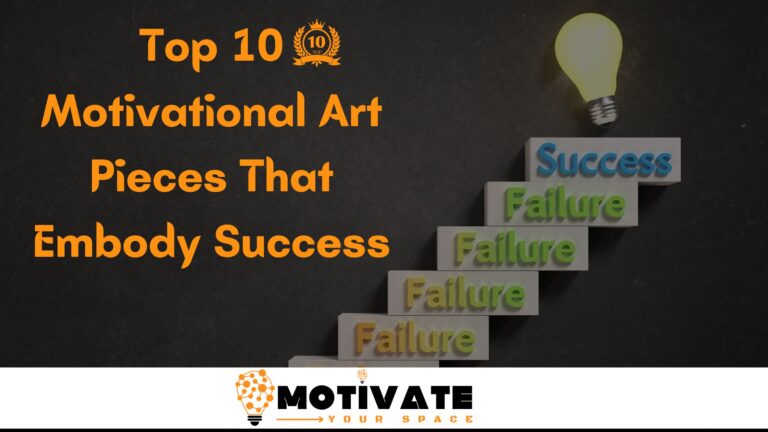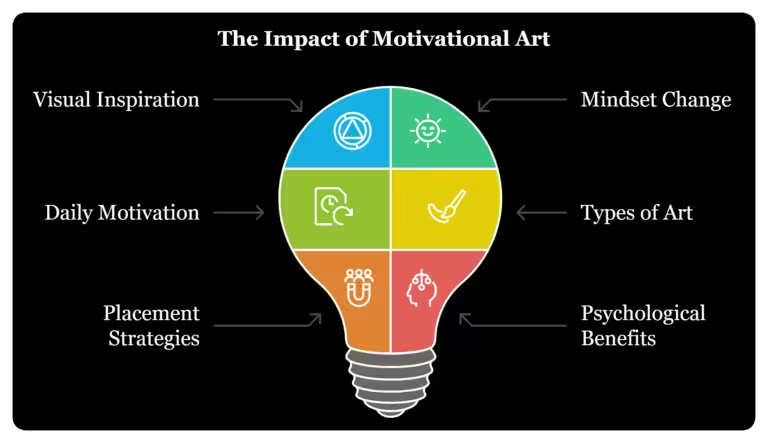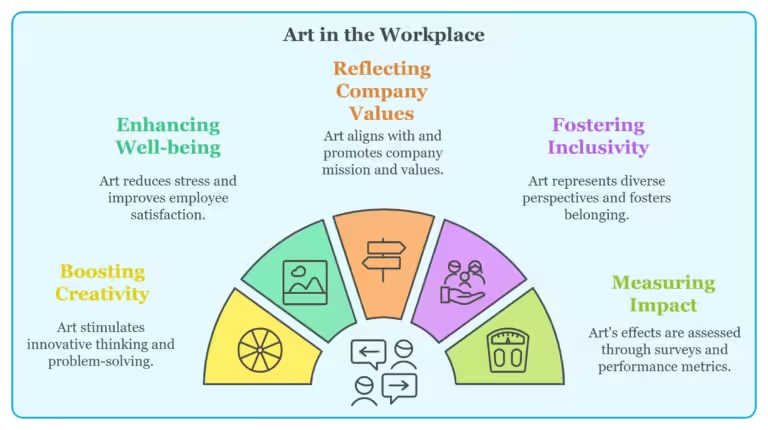The Intersection of Success And Art: A Motivational Perspective
Success and art often seem worlds apart. Yet, they intertwine more than you might think. The Intersection of Success And Art
At first glance, success and art appear to belong to different realms. Success often conjures images of financial achievement, leadership, and power. Art, on the other hand, evokes creativity, passion, and expression. So, how do these two seemingly distinct paths intersect?
This blog post explores this intriguing connection. We will dive into how the principles of art can inspire success and vice versa. Whether you’re an artist seeking motivation or a professional looking for a creative edge, understanding this intersection can be enlightening. Get ready to see success and art through a new lens. This perspective might just inspire your next big breakthrough.
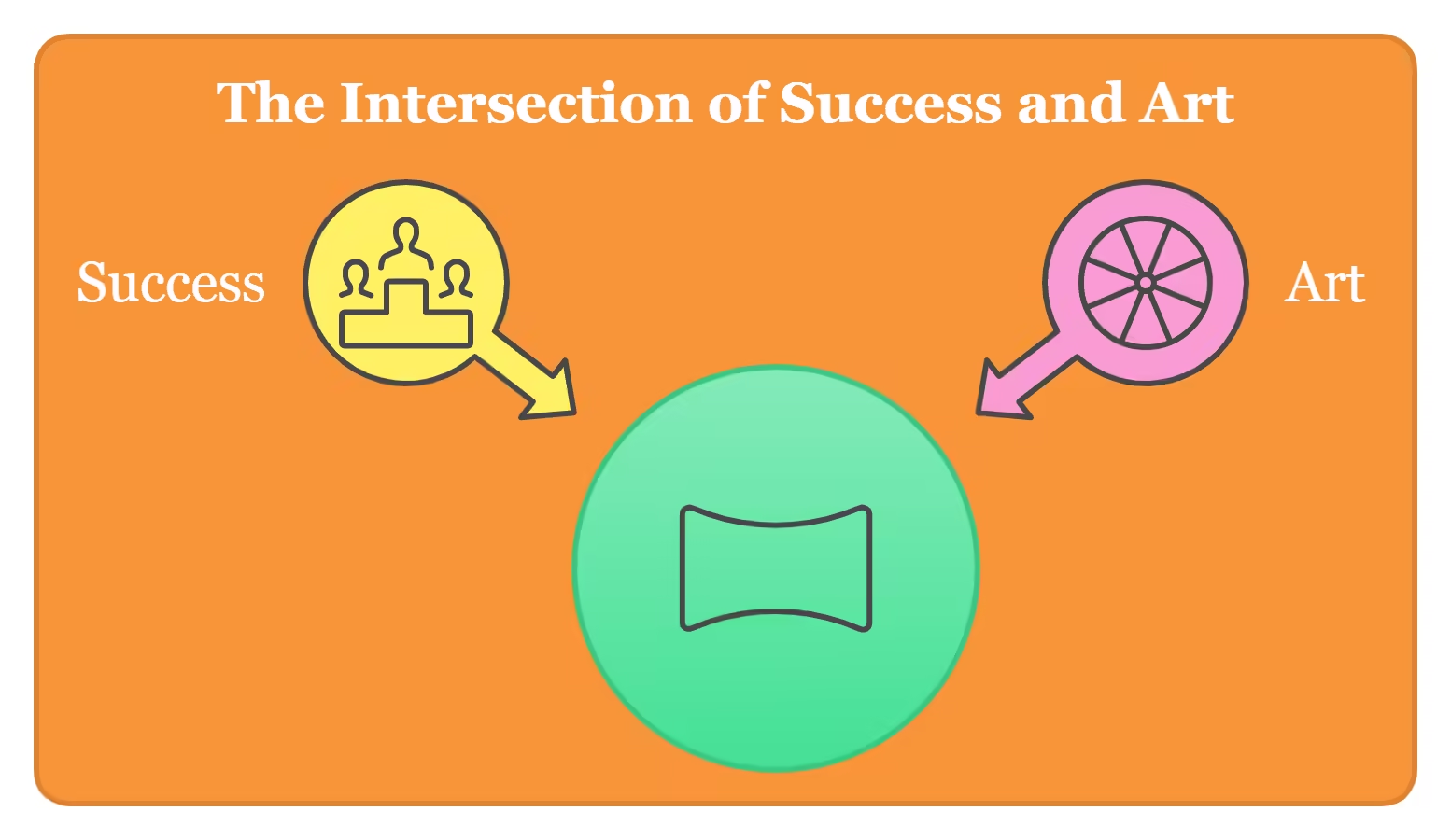
Success In Art
Success in art is a unique concept. Artists often measure their success differently. Unlike other fields, success in art is not just about financial gains. It encompasses personal satisfaction, recognition, and the impact of one’s work. This section delves into the meaning of success in art and artistic achievements.
Defining Success
Success means different things to different people. For some, it is about fame and wealth. For others, it is about personal fulfillment. In art, success can be a mix of both. It can mean creating something that resonates with others. It can also mean achieving mastery in a particular technique.
Artists often set their own benchmarks. These could be completing a challenging piece or having their work displayed in a gallery. It is important to note that success in art is subjective. What matters is what the artist feels.
Artistic Achievements
Artistic achievements come in various forms. They can be:
- Exhibitions in renowned galleries
- Winning art competitions
- Positive reviews from critics
- High sales of artwork
- Receiving commissions for projects
Each achievement boosts an artist’s confidence. It also helps build their reputation. Some artists create art that sparks social change. This too is a significant achievement.
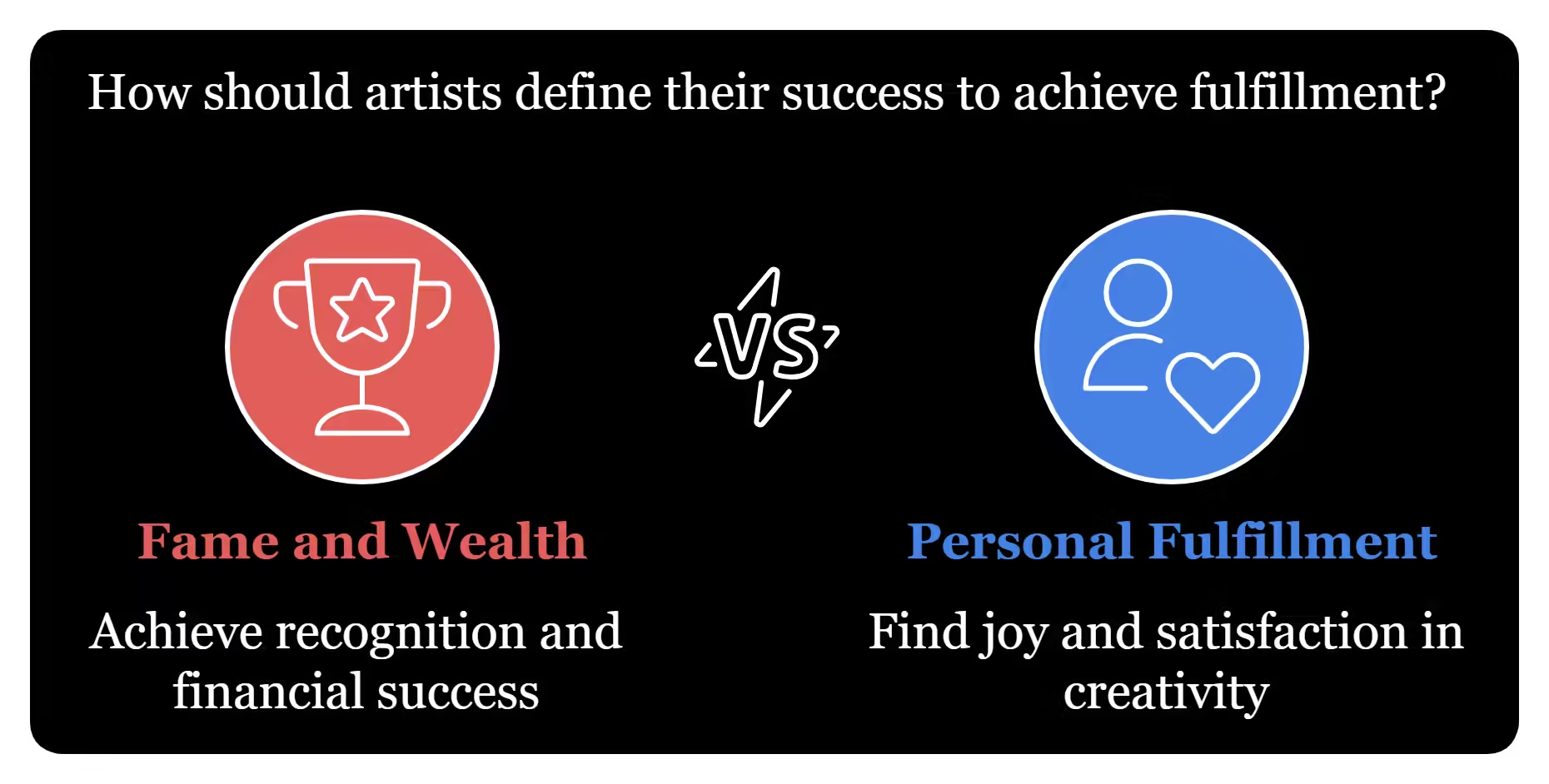
Many artists find joy in the process itself. Creating art can be therapeutic. It allows them to express their emotions. Each completed piece is a testament to their skills and creativity.
Ultimately, success in art is about making a difference. It is about touching lives through creativity. Every artist’s journey is unique. Their achievements, no matter how small, are significant milestones.
The Role Of Passion
The Role of Passion in the intersection of success and art is undeniable. Passion fuels dreams and drives individuals to create masterpieces. Without passion, art lacks soul, and success becomes hollow. Passion bridges the gap between hard work and creativity, making the journey worthwhile. Here, we delve into how passion plays a pivotal role in fueling creativity and sustaining motivation.
Fueling Creativity
Passion ignites the spark of creativity. When you are passionate, ideas flow effortlessly. Passion gives artists a unique vision and voice. This inner drive pushes boundaries and explores new realms. It allows artists to express their true selves.
Consider the following benefits of passion in fueling creativity:
- Originality: Passion leads to unique and original ideas.
- Innovation: Passion encourages experimentation and innovation.
- Resilience: Passion helps artists overcome creative blocks.
Passionate artists often produce work that resonates deeply with their audience. This connection is what makes art powerful and memorable.
Sustaining Motivation
Passion is the key to sustaining motivation. It keeps artists going even when faced with challenges. Without passion, the journey to success can feel exhausting.
Here are some ways passion sustains motivation:
- Consistency: Passion drives consistent effort and practice.
- Perseverance: Passion helps artists push through setbacks.
- Commitment: Passion ensures long-term dedication to their craft.
Passionate individuals remain motivated to achieve their goals. They view challenges as opportunities for growth. Their unwavering commitment often leads to remarkable success.
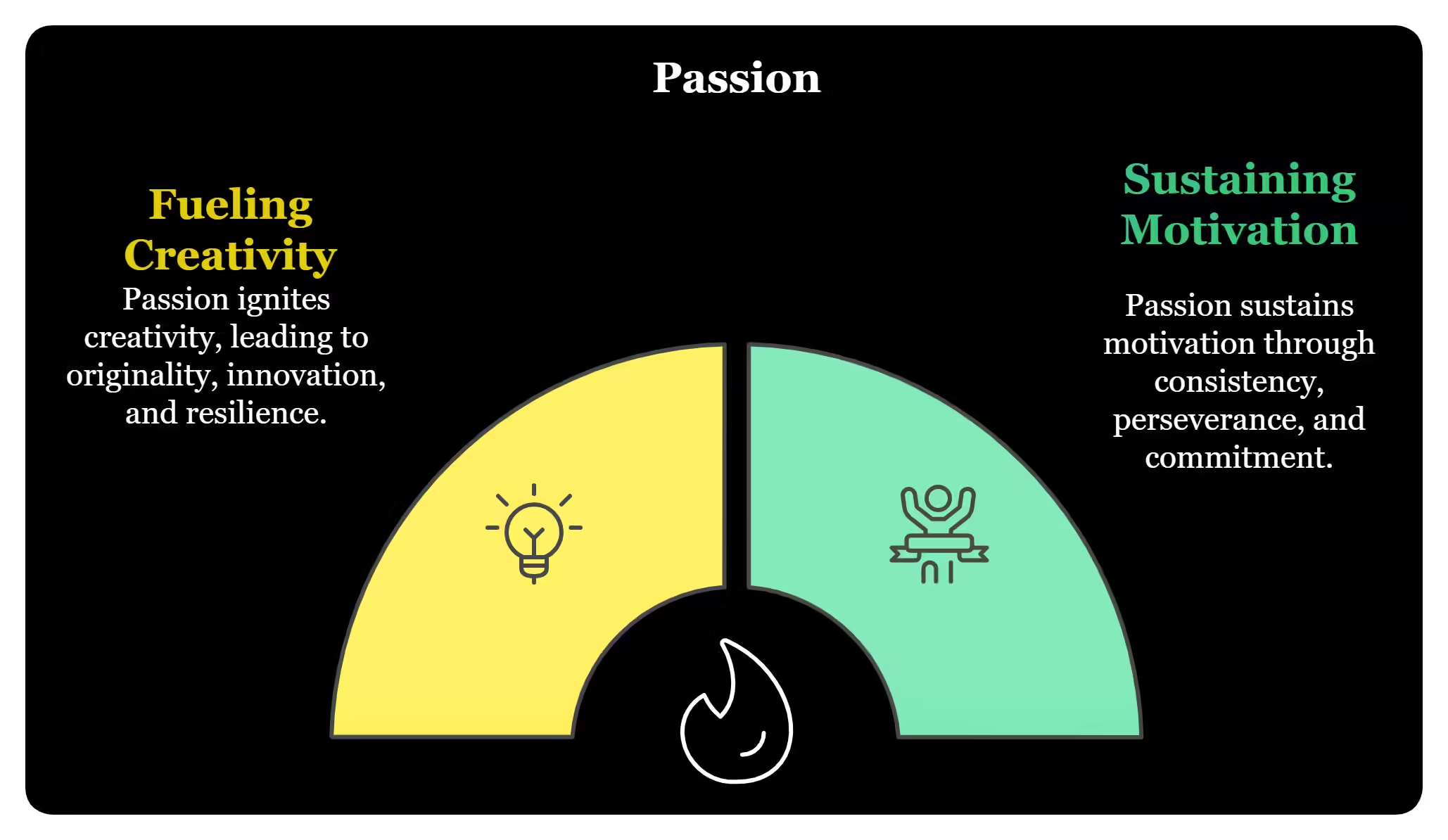
Overcoming Challenges
Overcoming challenges is a part of every artist’s journey. Success and art often intersect at the point of struggle. This intersection is where true growth happens. Facing hardships shapes an artist’s path, crafting their unique story.
Facing Criticism
Every artist encounters criticism. It’s unavoidable. Some feedback is constructive, some is not. The key is to remain open yet discerning. Use helpful critiques to improve your work. Ignore baseless negativity.
Criticism can feel harsh. But it offers a chance to grow. Listen to trusted voices. Filter out the noise. Learn from your mistakes. Stay focused on your vision.
Embracing Failure
Failure is a part of the creative process. It’s an inevitable step towards success. Embrace it. Each failure teaches a valuable lesson.
Consider failure as a stepping stone. It’s not the end but a beginning. Failures refine your skills. They make you resilient. Don’t fear failure. Welcome it. Learn from it.
Here are some ways to turn failure into success:
- Analyze what went wrong.
- Seek feedback from mentors.
- Make necessary improvements.
- Keep experimenting with new ideas.
Remember, each setback is an opportunity. An opportunity to grow and evolve.

Building A Support System
Success and art are intertwined. Both require passion, dedication, and a solid support system. A strong support system can help artists achieve their goals. It provides guidance, encouragement, and a sense of community. This section explores the importance of a support system for artists.
Mentors And Peers
Mentors play a vital role in an artist’s journey. They offer valuable insights, share experiences, and provide constructive feedback. Finding a mentor can be a game-changer for artists.
Peers are equally important. They offer camaraderie and understanding. Peers can share in struggles and celebrate successes. This mutual support creates a nurturing environment.
Here are some ways to connect with mentors and peers:
- Attend workshops and seminars
- Join online forums and social media groups
- Participate in local art events
Community And Networking
Being part of a community is essential for artists. It provides a platform to showcase work, gain feedback, and build relationships. Networking within the community opens doors to new opportunities.
Networking can be done in various ways:
- Attend art exhibitions and galleries
- Join art associations and clubs
- Collaborate on projects with other artists
Both community and networking contribute to an artist’s growth. They provide a sense of belonging and open up new possibilities.
Here’s a simple table showing benefits of community and networking:
| Community | Networking |
|---|---|
| Provides support and feedback | Opens new opportunities |
| Creates a sense of belonging | Builds professional relationships |
| Encourages growth and learning | Expands reach and influence |
Both mentors and peers, as well as community and networking, are crucial. They form the backbone of an artist’s support system. This support system is essential for achieving success in the world of art.
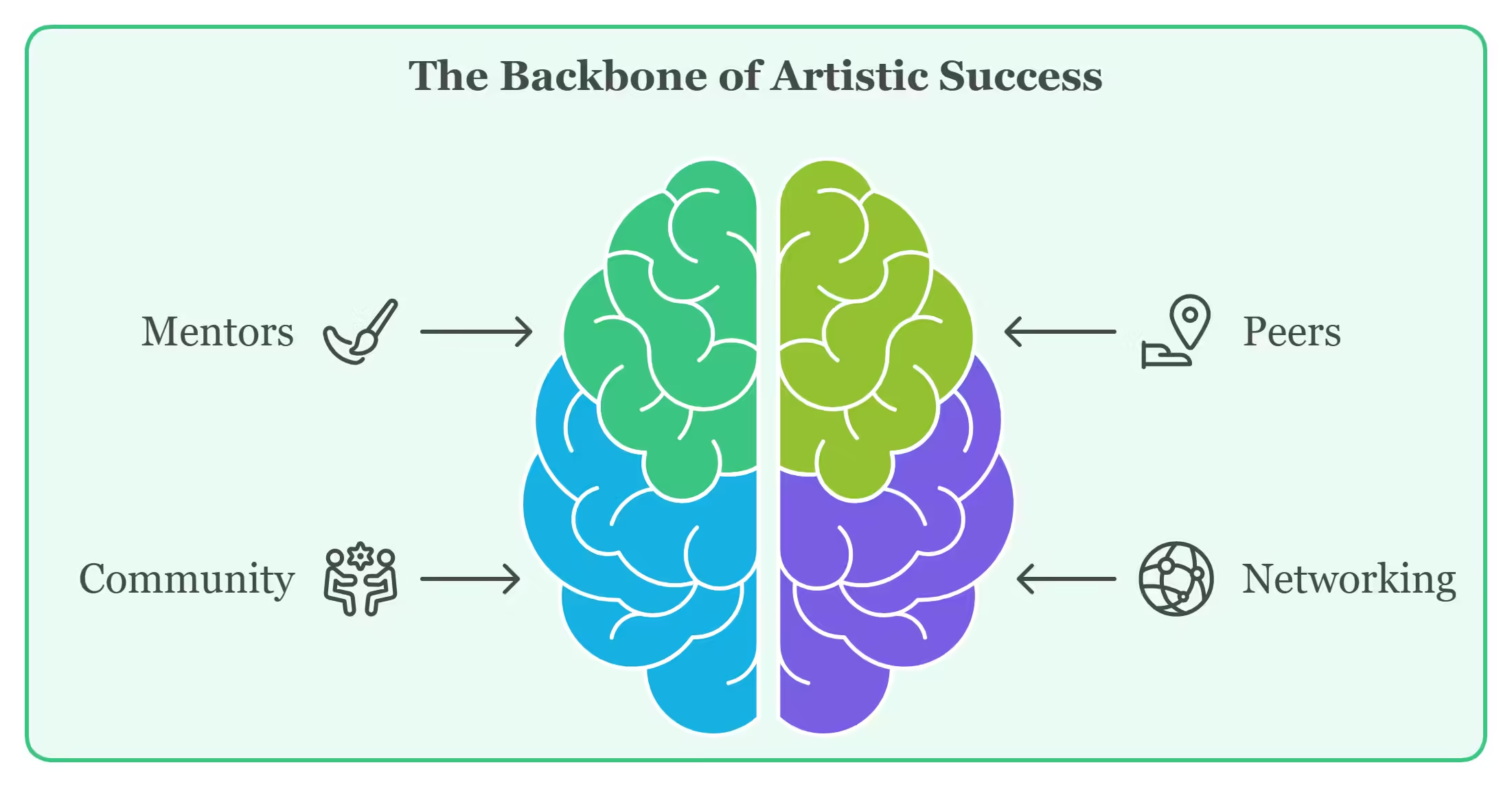
Balancing Art And Commerce
Finding the sweet spot between artistic passion and financial success is a challenge. Many artists struggle to balance their creative freedom with the need to earn a living. This intersection of art and commerce can be a delicate balancing act, but it is possible to achieve both. Let’s explore how.
Monetizing Creativity
Turning creativity into income requires strategic planning. Artists can sell their work online through various platforms. Websites like Etsy, Redbubble, and Society6 allow artists to showcase and sell their art.
Another way to monetize creativity is through commissions. Artists can create custom pieces for clients, which can be both profitable and rewarding. Teaching art classes or workshops is another great way to earn money. Sharing skills with others can be fulfilling and financially beneficial.
Artists can also look for opportunities to license their artwork. Licensing allows companies to use an artist’s designs on products. This can include anything from clothing to home decor. Licensing agreements can provide a steady income stream.
Maintaining Artistic Integrity
While making money is important, maintaining artistic integrity is crucial. Artists should stay true to their vision and values. This means creating work that resonates with their personal style and message.
It can be tempting to create art that sells well, but this can lead to burnout. Staying authentic helps maintain passion and creativity. Artists should find a balance between commercial work and personal projects.
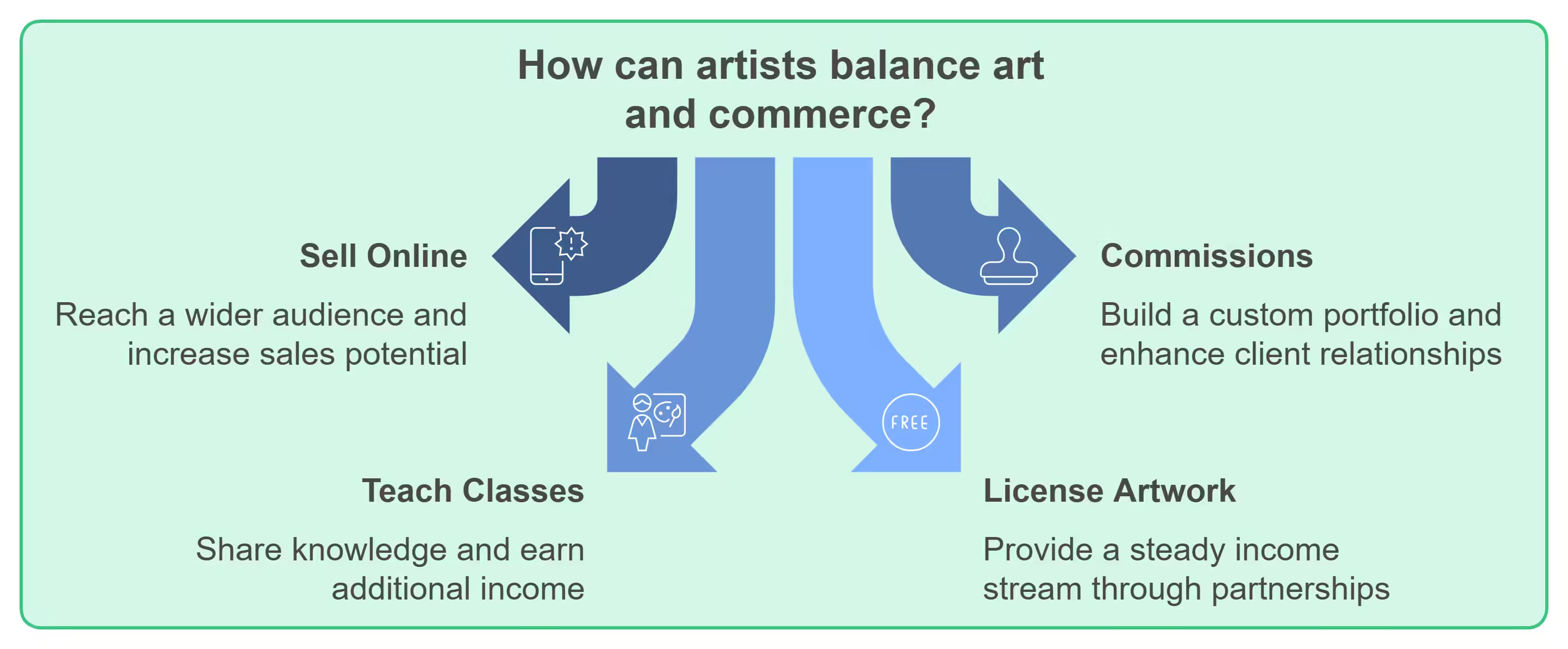
Setting boundaries is key to maintaining artistic integrity. Artists should clearly communicate their limits with clients. This ensures that their work remains true to their vision.
| Strategies | Benefits |
|---|---|
| Sell Online | Reach a wider audience |
| Commissions | Build a custom portfolio |
| Teach Classes | Share knowledge and earn |
| License Artwork | Steady income stream |
Balancing art and commerce can be challenging, but it’s possible. With strategic planning and staying true to their vision, artists can find success.
Personal Growth Through Art
Art is not just about creating beautiful pieces. It is a journey that fosters personal growth. Engaging in art can lead to self-discovery and emotional expression. Let’s explore how.
Self-discovery
Creating art helps you discover yourself. It brings out your inner thoughts and feelings. You may find hidden talents or passions. This process of self-discovery is crucial for personal growth.
Art allows you to explore different aspects of your personality. It provides a safe space to experiment and learn. Through art, you can understand your strengths and weaknesses better.
- Uncover hidden talents
- Explore personal interests
- Learn about strengths and weaknesses
Emotional Expression
Art is a powerful medium for emotional expression. It helps you convey feelings that are hard to put into words. This can be very therapeutic and healing.
Creating art can reduce stress and anxiety. It provides a healthy outlet for pent-up emotions. By expressing your emotions through art, you can achieve a better emotional balance.
| Benefits of Emotional Expression Through Art |
|---|
| Reduces stress and anxiety |
| Improves emotional balance |
| Provides a healthy emotional outlet |
Art can also help you understand and process complex emotions. This deeper understanding can lead to personal growth and improved mental health.
- Reduce stress
- Improve mental health
- Understand complex emotions
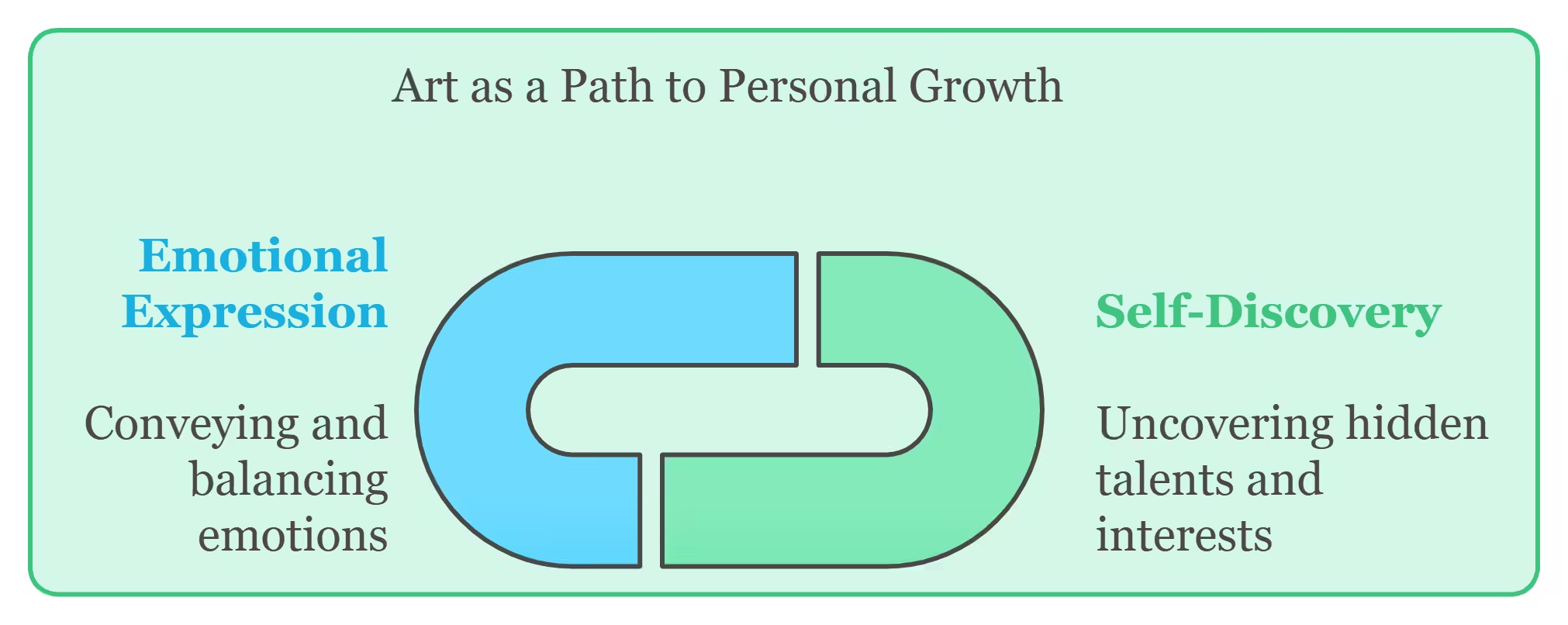
Inspirational Case Studies
Understanding the intersection of success and art requires looking at inspirational case studies. These stories show how dedication, passion, and talent can lead to remarkable success. Let’s dive into some examples that highlight both renowned artists and emerging talents.
Renowned Artists
Many artists have left a significant impact on the world through their work. Their journeys are filled with hard work, resilience, and an unyielding spirit.
- Vincent van Gogh: Van Gogh faced many challenges in his life. He struggled with mental health issues and financial difficulties. Despite this, he created over 2,100 artworks, including 860 oil paintings. Today, his works are celebrated worldwide.
- Pablo Picasso: Picasso’s unique style made him one of the most influential artists of the 20th century. He experimented with various styles and techniques, creating over 50,000 artworks. His dedication to art helped him achieve great success.
- Frida Kahlo: Kahlo’s art was deeply personal and often reflected her pain and suffering. She faced many health issues but continued to create powerful and evocative paintings. Her work has inspired many and remains influential today.
Emerging Talents
New artists are constantly emerging, bringing fresh perspectives and creativity. Their stories of perseverance and innovation are equally inspiring.
- Yayoi Kusama: Kusama began her career in a conservative society that did not support her art. She moved to New York and faced many struggles. Her persistence paid off, and she is now one of the most prominent contemporary artists.
- Jean-Michel Basquiat: Basquiat started as a street artist. His unique style caught the attention of the art world. Despite his short life, he made a lasting impact and his works are highly valued today.
- Banksy: Banksy’s identity remains unknown, but his art speaks volumes. His thought-provoking graffiti has appeared in many cities, often with powerful social and political messages. Banksy’s work continues to challenge and inspire.
These case studies show that success in art comes from passion and dedication. Renowned artists and emerging talents alike demonstrate that with perseverance, one can achieve greatness.

Practical Tips For Artists
Every artist dreams of success. Yet, the journey to success can seem daunting. Here are some practical tips to help artists stay on track and reach their goals. These tips are designed to be simple, actionable, and effective.
Setting Goals
Setting goals is crucial for any artist. Goals give direction and purpose. They help track progress and maintain focus.
- Start with small, achievable goals. This builds momentum.
- Set both short-term and long-term goals. Balance is key.
- Write down your goals. This makes them more real.
- Review your goals regularly. Adjust them as needed.
Staying Disciplined
Discipline separates successful artists from the rest. It is the bridge between goals and achievement.
- Establish a consistent routine. Stick to it.
- Dedicate specific time blocks for art. Treat it like a job.
- Avoid distractions during creative hours. Stay focused.
- Take breaks to avoid burnout. Rest is important.
| Activity | Frequency |
|---|---|
| Sketching | Daily |
| Painting | Weekly |
| Art Classes | Monthly |
By setting clear goals and staying disciplined, artists can navigate the path to success with confidence and clarity. These practical tips serve as a foundation for creating art and achieving dreams.
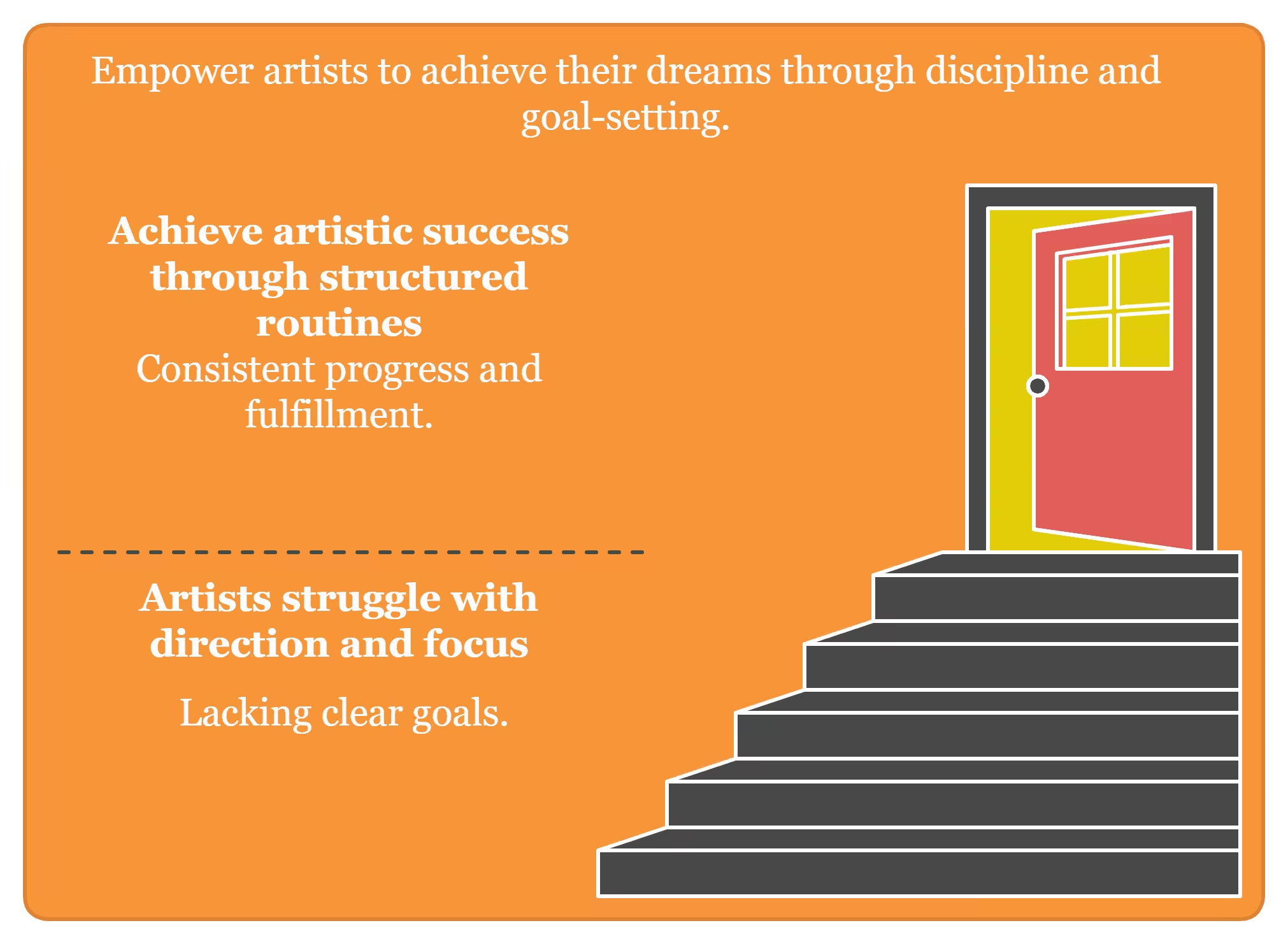
Frequently Asked Questions
How Does Art Influence Success?
Art fosters creativity, critical thinking, and problem-solving skills. These skills are essential for achieving success in various fields. Engaging with art also enhances emotional intelligence, which helps in building better relationships and effective communication.
Can Art Boost Motivation?
Yes, art can boost motivation. It provides a sense of accomplishment and personal satisfaction. Creating or appreciating art can inspire individuals and trigger new ideas, enhancing overall motivation.
What Role Does Creativity Play In Success?
Creativity is crucial for success. It enables innovative solutions to problems, fosters resilience, and enhances adaptability. Creative thinking helps individuals stand out and achieve their goals more effectively.
Is There A Link Between Art And Mental Well-being?
Yes, there is a strong link between art and mental well-being. Engaging with art reduces stress, improves mood, and enhances overall mental health. It provides an outlet for self-expression and emotional release.
Conclusion
Success and art share a deep connection. Both require passion and dedication. They inspire creativity and drive. Artists and successful individuals face similar challenges. They overcome obstacles with determination. This journey fosters growth and fulfillment. Embrace your artistic side to find success.
Let creativity guide your path. Strive for excellence in all endeavors. Success and art together create a meaningful life.

